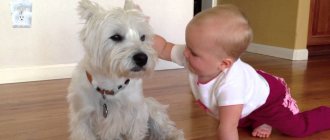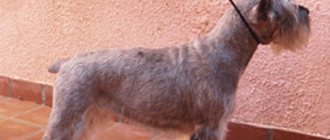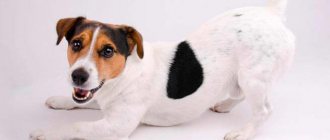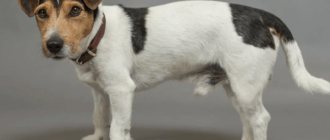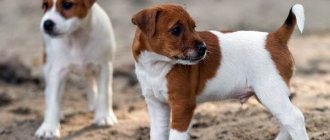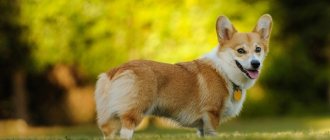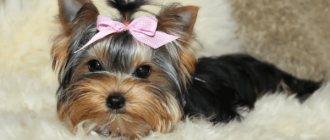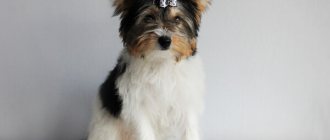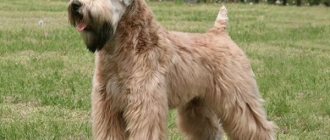Quite often, professional dog handlers call the Irish Terrier a dog of contrasts. Indeed, in what other breed are such seemingly incompatible qualities so closely intertwined, such as absolute obedience and pride, energy and self-control, intelligent sophistication and unpretentiousness, courage and endurance, boundless, puppy-like gaiety?
According to owners' reviews, the Irish Terrier is able to adapt to any lifestyle of the owner. He loves his family selflessly and gives his whole soul to his children. This charming red dog can be a wonderful “actor” who selflessly “sings” to the music. His reputation as a fighter is greatly exaggerated - he fights no more often than other dogs.
History of the breed
The Irish Terrier is perhaps one of the oldest representatives of a large family. It appeared on the territory of Ireland, presumably about two thousand years ago. Ancient manuscripts kept in the Dublin History Museum contain descriptions of dogs similar to modern terriers, and the first drawing of these animals dates back to 1700. It is believed that the ancestors of the Irish Terrier were the Irish Wolfhound or the Black and Tan Wirehaired Terrier.
In the distant past, these animals were not kept for their hunting qualities or beauty - they were unsurpassed rat catchers. Their main purpose was not to hit their article, but to crush rodents. Size, color and other characteristics did not matter much.
Breeding work with the breed began only at the end of the 19th century, when dog shows began to be held more often. During the same period, a fashion for indigenous breeds emerged. The very first club of breed lovers began its work in Dublin (1879). The English Kennel Club recognized these animals and classified them as the native terriers of Ireland.
It is quite natural that these dogs gained the greatest popularity in their homeland, but due to their great love for children, the breed gradually began to spread throughout the world.
Head
The head is long, the forehead is not wide between the ears and is flat. It gradually narrows towards the eyes. The transition from forehead to muzzle is practically invisible. The nose is black. The lips are dry, tightly fitting, and the outside is dark, almost black.
The eyes are small, dark in color, not protruding. Light or yellow eyes are not accepted by the standard.
The Irish Terrier's ears are small, of moderate thickness, and V-shaped. They are set high and directed forward, close to the temples. The top fold of the ears is noticeably higher than the level of the forehead. Ears that droop to the sides of the head are a disqualifying factor, as are semi-erect ears. The fur covering the ears is darker and shorter than that on the body. The weight and height of different dogs may vary, but usually the average weight of a male is about 15 kg, and that of a female is 13 kg. At the withers, height is from 46 to 50 cm.
Description and characteristics of dogs
The Australian Shepherd Dog has a unique appearance that sets it apart from other breeds. Their complete appearance was formed only at the beginning of the 20th century, when a complete description of the Aussie was recorded. According to generally accepted breed standards, the dog looks like this:
- Large head with a short muzzle, triangular ears of medium length.
- The nose depends on the color of the coat; it can be red or black.
- The eyes are almond-shaped and come in a variety of shades - brown, blue, green. Sometimes inclusions or marbling are observed.
- The coat is hard, wavy or straight, medium length, marbled in color. It is moderately dense, the degree of density is influenced by climate. The hair is shorter near the ears, forelimbs and head.
- The docked tail is a distinctive feature of the Australian Shepherd. There are individuals with a tail of natural length.
Aussie is considered a medium breed, height at the withers is 45-60 cm, weight is 15-35 kg. As with other dogs, the size of the animal depends on the sex - females are much smaller than males. There is a miniature breed, their height and weight characteristics are different.
People often wonder what the external differences are between an Australian Shepherd and a Border Collie. They are very similar in color and coat, so they are confused. Dogs have different shapes of muzzle and body, ears, and sizes. Among collies there are short-haired representatives.
With proper care, the average life expectancy of an Aussie is approximately 12-14 years.
Character
Let's look at everything about the breed's character. The main qualities are responsibility and hard work. They have an affectionate disposition, a desire to please their owner, and are distinguished by their kindness. You need to walk dogs for a long time, since people's attention is valuable to them.
The activity of animals is very high, so they should not be in a confined space. To express your qualities and feel good, you need space and freedom. Australian Shepherd lovers emphasize loyalty and devotion. They also have developed intelligence and high learning abilities, which makes the training process easier. The dogs themselves like to learn commands and carry out tasks.
Aussies are considered a family animal. She will get along well with the child - she will act as a nanny, protect him and play with him. These dogs are good guards. Knowing their place, they can be aggressive with strangers. If training is neglected, instincts will interfere with the owners. Dogs are usually friendly to humans, but are often wary when strangers appear. If a pet is too aggressive or cowardly, this is considered a deviation.
Animals are very energetic, so without walks and exercise their mood deteriorates, they begin to misbehave and show the negative side of their character. The Shepherd needs attention. These are not only walks, but also training, various tasks (security, jogging behind the owner’s bicycle, grazing livestock). Only in this way will the dog spend energy in a peaceful direction. Her herding instincts are at a very high level.
These characteristics indicate that the breed is not suitable for everyone. Homebodies and lovers of a relaxing holiday will not find mutual understanding with such a dog. Pets are perfect for helping a person with disabilities, as service dogs and guide dogs. They often take part in rescue operations and help the police. In the north they are used in transportation.
Colors
Wool comes in different colors, usually a combination of several shades. The most popular colors are black, red, red marble, blue marble, black tricolor.
Color
Until 1880, the color of the Irish Terrier was not completely formed. In addition to the red one, animals with a motley or black and tan color were occasionally encountered. At the end of the 19th century, a lot of work was done to eliminate the mating of motley and black and tan dogs with each other. As a result, by the beginning of the 20th century, all representatives of this breed had a red color. Today, bright red, golden red and reddish-wheaten coat colors are allowed.
When describing the Irish Terrier breed, it should be noted that puppies may have even coarser hair, a dark mask on the face, darkened tips of the hairs on the body or a stripe on the back. With age, this blackness disappears.
The best nicknames for an Australian Shepherd
Choose a name for your Aussie that is bright, sonorous and dynamic - it will fit well into the image of this dog. Names with an American or English flavor are good for Australian Shepherds.
For such a smart and beautiful girl, an appropriate name is required
For boys
Examples of successful names for Aussie boys:
- Brighton;
- Brooklyn;
- Brooks;
- Hastings;
- Hudson;
- Cambridge;
- Cromwell;
- Maxwell;
- Malibu;
- Madison;
- Richmond;
- Chaplin;
- Churchill;
- Sherman;
- Sherlock.
For girls
Examples of successful names for Aussie girls:
- Berry;
- Britney;
- Violet;
- Ginger;
- Camilla;
- Cola;
- Christie;
- Lady;
- Millicent;
- Pepsi;
- Sky;
- Smalley;
- Trinity;
- Hessie.
Character
Today no one perceives Irish terriers solely as rat catchers. They became watchmen and just pets. This dog always closely monitors its territory and always gives a sign to its owner if it detects disorder. Puppies require socialization, otherwise they will be too wary of strangers. The nature of the Irish Terrier has preserved the hunting instinct, therefore small animals living in your house are unlikely to be able to establish close friendships with the new tenant.
When walking, it is better not to let the “Irishman” off the leash, since he can immediately start hunting for cats, for example. These terriers also do not like their same-sex relatives, with whom they start fights at the first opportunity.
Socialization of a puppy should begin with getting to know dogs, teaching the baby not to fight or try to dominate others. Dog handlers believe that novice dog breeders and people who lack self-confidence should not own such a breed, since raising such a pet requires, in addition to experience, also pronounced leadership qualities of the owner.
For a puppy of this breed, it is necessary to set strict rules and limits, keep the baby within them, but at the same time maintain restraint and calm. Training, active games, traveling with the owner will help the animal give vent to its irrepressible energy. During walks, the dog should be next to the owner, and not in front. According to terriers, the owner is the one who is in front.
In a surprising way, the Irish Terrier relates to the family in which it lives. He loves all its members and is ready to care for and protect each of them. A well-mannered “Irishman” behaves decently during a walk, and if necessary (if, for example, the owner has entered a store) he will patiently wait for him in a secluded place.
He is kind and gentle towards children. However, you should not leave him alone with the kids - the dog will under no circumstances offend the child, but in the game he may accidentally push him. The Irish Terrier should not be owned by people who do not have the opportunity to devote time to the dog for daily long walks. It is unlikely that older people will be able to cope with raising such a pet.
Terrier care
Quite unpretentious and small-sized, representatives of this breed feel equally comfortable in a private home or apartment. But they need daily activity and serious physical activity. Such a dog does not require complex care - its coat does not get wet and does not absorb dirt. Bath animals when absolutely necessary.
Thick coats should be brushed periodically. The beard and mustache are combed very carefully, starting from the ends, so as not to cause any unpleasant sensations to your pet. The main hygienic procedures in caring for the Irish Terrier include:
- cleaning ears from dirt;
- observation of the oral cavity;
- regular checks with a veterinarian for infections;
- nail trimming (once a week);
- washing the eyes.
Many owners consider the absence of shedding to be an advantage of this breed. Trimming is required twice a year. During this procedure, the fur is cleaned of dead hairs. You are unlikely to be able to perform competent trimming on your own for the first time, so it is better to entrust this procedure to a professional.
Irish Terrier puppies are very active and energetic. They need regular exercise and outdoor play. This will help raise a healthy dog and keep it in great shape.
What to feed
The Irish Terrier is unpretentious in food, but in order to avoid gaining excess weight, you should follow some rules when preparing your diet:
- Most of it should be protein foods.
- For this breed, underfeeding is better than overfeeding.
- Adult dogs are fed twice a day, with most of the food consumed in the first half of the day.
- The dog should always have free access to clean drinking water.
Feeding the Irish Terrier is allowed both natural products and ready-made food. Breeders try to feed their pets with ready-made formulas, giving preference to products from well-known manufacturers.
When choosing what to feed your puppy, listen to the advice of dog experts: they recommend using professional food, in accordance with the baby’s age. As a rule, such formulations include all the vitamins and minerals necessary for a growing dog’s body.
If you think that it is better for your pet to eat natural foods, then you must understand that most of the favorite human dishes are useless and sometimes extremely harmful for the dog. For it, you need to prepare separate dishes without salt and spices.
Vegetable purees should be varied with meat or boiled sea fish. Boiled lean meat (veal, beef, rabbit, turkey) should be added to porridge cooked in water.
Aussie diet
Aussies require a balanced diet, mostly natural food. Dry food should make up no more than 30% of the daily menu. Dry food should only be premium and low in protein. Natural feeding should include:
- Meat and offal (low-fat);
- Fish;
- Milk, kefir, cottage cheese;
- Cereals (rice, buckwheat, oatmeal);
- Vegetables, fruits and berries.
It is forbidden to give sweets, pork, flour products, sausage and raw eggs. Feeding is carried out according to a schedule, Aussies adhere to it perfectly, they rarely become obese. Two or three feeding sessions are enough with a daily regimen of two 40-minute walks. Some dog breeders add special vitamin complexes to their products.
Training
The Irish Terrier is an intelligent and quickly trained dog, although it is not without its share of stubbornness and self-will. Surprisingly, despite their boundless devotion, these dogs do not strive to please their owner with their successes. For this reason, this breed should be trained using positive reinforcement and treats, and commands should be short and clear.
This is a dog with a strong character and pronounced personality. Training such a pet should least of all resemble drill. The owner of the animal faces a difficult task - to turn every training session into a game, an exciting activity, so that the dog’s rights are not infringed.
The handsome red-haired man will not tolerate punishment even from his beloved owner - he will be offended, and all the results achieved will be crossed out by a single wrong action. It is necessary to do everything gently, not to offend the dog, but to try to convince him. Persistence and consistency are very important in training. Don't try to learn multiple commands at the same time. You should move on to a new task after mastering the previous one.
The dog gets tired of repeating exercises monotonously, so the 30-minute training session should be divided into learning commands and games. You should move on to combined complex commands when you are sure that you are in complete control of the animal’s behavior, and your pet is ready to continue training.
Irish Terrier: owner reviews
Many owners of these animals admit that this is a difficult breed. At home they are flexible and complex, but on a walk they turn into a hurricane, a sea of positivity and movement. Despite some problems in education, terriers are always family pets. They are smart, clean, and love their family immensely. Owners of such pets recommend that newcomers to dog breeding avoid shouting and physical punishment. Carrot and stick is not a method for a terrier. Such a dog can be adopted by people who are patient, calm and non-aggressive.
Clumber Spaniel: puppies
These babies are very active and they grow very quickly. Of course, growth slows down with age. Every day you need to go for long walks with your puppy; do not forget to always put a leash on your pet. These adorable little ones love to play fetch when out and about. Daily walks are extremely important for your pet's mental health. Don't let your dog run ahead on a walk. The puppy must understand that the leader is the person. In addition, these dogs love to swim from an early age, so do not deprive your pet of this pleasure.
